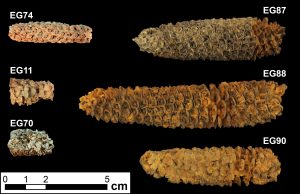It’s aMAIZEing what food can reveal
Heather B. Thakar, instructional assistant professor of anthropology, uses food remains from archeological sites to learn about the past.

 The first steps toward maize (Zea mays subspecies mays) domestication occurred in the Balsas region of Mexico by ∼9,000 calendar years B.P. (cal B.P.), but it remains unclear when maize was productive enough to be a staple grain in the Americas. Molecular and microbotanical data provide a partial picture of the timing and nature of morphological change, with genetic data indicating that alleles for some domestication traits were not yet fixed by 5,300 cal B.P. in the highlands of Mexico. Here, we report 88 radiocarbon dates on the botanical remains from El Gigante rock shelter (Honduras) to establish a Bayesian chronology over the past ∼11,000 y spanning the transition to maize-based food production. Botanical remains are remarkably well preserved and include over 10,000 maize macrofossils. We directly dated 37 maize cobs to establish the appearance and local change of maize at the site. Cobs are common in deposits dating between 4,340 and 4,020 cal B.P., and again between 2,350 and 980 cal B.P. The earliest cobs appear robustly domesticated, having 10–14 rows, suggesting strong selection for increased yield. The later cobs are comparable to these earliest ones, but show clear emergence of diverse traits, including increased cob width, rachis segment length, and cupule width. Our results indicate that domesticated landraces of maize productive enough to be a staple grain existed in Central America by 4,300 cal B.P.
The first steps toward maize (Zea mays subspecies mays) domestication occurred in the Balsas region of Mexico by ∼9,000 calendar years B.P. (cal B.P.), but it remains unclear when maize was productive enough to be a staple grain in the Americas. Molecular and microbotanical data provide a partial picture of the timing and nature of morphological change, with genetic data indicating that alleles for some domestication traits were not yet fixed by 5,300 cal B.P. in the highlands of Mexico. Here, we report 88 radiocarbon dates on the botanical remains from El Gigante rock shelter (Honduras) to establish a Bayesian chronology over the past ∼11,000 y spanning the transition to maize-based food production. Botanical remains are remarkably well preserved and include over 10,000 maize macrofossils. We directly dated 37 maize cobs to establish the appearance and local change of maize at the site. Cobs are common in deposits dating between 4,340 and 4,020 cal B.P., and again between 2,350 and 980 cal B.P. The earliest cobs appear robustly domesticated, having 10–14 rows, suggesting strong selection for increased yield. The later cobs are comparable to these earliest ones, but show clear emergence of diverse traits, including increased cob width, rachis segment length, and cupule width. Our results indicate that domesticated landraces of maize productive enough to be a staple grain existed in Central America by 4,300 cal B.P.
You can view the full publication here.
